Chapter 16 Phyllis Della-Latta; Richard C. Huard; Susan Whittier; Fann Wu Questions A. The MIC is the lowest drug level that can reach all sites of infection. B. The MIC is the amount of drug that can be administered in a single dose. C. The MIC is the lowest drug level that is bacteriostatic. D. The MIC is the lowest drug level that is nontoxic. E. The MIC is the lowest drug level that kills the bacterial pathogen. 2. A 70-year-old man presents to his physician with a 2-day history of fever, malaise, chest pain, and a productive cough. No upper respiratory symptoms were noted. Laboratory testing shows an elevated peripheral blood leukocyte count and a chest radiograph shows lobar consolidation. The Gram stain of a sputum specimen sent for bacterial culture is shown in Figure 16-1. Which one of the following is the etiologic agent? B. Legionella pneumophila. C. Mycoplasma pneumonia. D. Streptococcus pneumonia. E. Staphylococcus aureus. 3. Gram-negative bacilli causing infections in health care settings often produce extended-spectrum β-lactamases (ESBLs). Which one type of the following antimicrobial agents is most appropriate for treating ESBL-producing pathogens? B. Third-generation cephalosporins. C. First-generation cephalosporins. D. Second-generation cephalosporins. E. Aztreonam. 4. A blood culture set was drawn from an adult patient with a fever of 101°F. The following day, the laboratory reported the presence of gram-positive cocci in the arrangement depicted in the Figure 16-2. What is the presumptive identification of this morphotype? B. Coagulase-negative staphylococci. C. Streptococcus pneumoniae. D. Staphylococci. E. Enterococci. 5. A 70-year-old woman presents to her urologist with a urinary tract infection. Culture results indicate that the infecting pathogen is Escherichia coli, which has an MIC interpreted as “intermediate” for the antimicrobial agent of choice. Which one of the following statements best describes this MIC interpretation for this antibiotic? A. The patient is likely to not respond to treatment with this antibiotic. B. This antibiotic may be efficacious either at higher doses or if concentrated in the urine. C. Antibiotics with intermediate interpretations cannot be dosed at therapeutic levels. D. An intermediate result indicates a technical error and must be repeated using the disk diffusion susceptibility method. E. The intermediate category is interpreted as nonsusceptible. 6. The incidence and prevalence of etiologic agents causing sexually transmitted infections are underestimated due to diagnostic challenges and social stigma. Which one of the following statements regarding sexually transmitted infections is most accurate? B. Nucleic acid amplification tests (NAATs) are the most sensitive and accurate method for detecting Neisseria gonorrhea and Chlamydia trachomatis infections. C. Dark-field microscopic examination is used to diagnose herpes simplex ulcerative genital lesions. D. Haemophilus ducreyi is the causative agent of lymphogranuloma venereum. E. Syphilis is currently on the rise in the adolescent population in urban settings. 7. A 24-year-old immunocompetent farm worker who was 27 weeks pregnant presented with a fever of 102°F, headache, a 1-day history of diarrhea, and decreased fetal movements. Labor was induced and a stillborn infant was delivered vaginally. The Gram stain from a positive blood culture and colonial morphology on blood agar provided a presumptive identification (Figure 16-3). Which one of the following bacterial pathogens is the most likely cause of sepsis in this patient? A. Streptococcus agalactiae (group B streptococci [GBS]). B. Chlamydia trachomatis. C. Listeria monocytogenes. D. Neisseria gonorrhoeae. E. Campylobacter jejuni. 8. A febrile 4-year-old child was admitted to the pediatric intensive care unit with a petechial rash and lethargy. A lumbar puncture revealed an elevated protein level of 200 mg/dL, a decreased glucose level of 30 mg/dL, and a predominance of neutrophils. A Gram stain of the cerebrospinal fluid revealed the pathogen shown in Figure 16-4. Which one of the following etiologic agents is the cause of the child’s meningitis? B. Haemophilus influenza. C. Streptococcus pneumonia. D. Neisseria meningitidis. E. Listeria monocytogenes. 9. An 11-year-old patient presented to the emergency department with fever and axillary lymphadenopathy. Erythematous papules are noted on the right hand and forearm. A Gram stain and a Kinyoun acid-fast stain of a lymph node biopsy were both negative, as were cultures of the biopsy and blood cultures that were incubated for 5 days. The family has a 2-month-old kitten that they recently adopted from a shelter. The diagnosis was made using a serologic assay. Which one of the following is the most likely cause of the disease in this patient? A. Streptobacillus moniliformis. B. Borrelia burgdorferi. C. Coxiella burnetii. D. Bartonella henselae. E. Mycobacterium haemophilum. 10. A 5-year-old child presented to her pediatrician with bloody diarrhea of 2 days’ duration accompanied by abdominal cramps and dehydration. She was afebrile. She had become symptomatic 4 days after consuming potato salad, a hamburger, and milk. Examination of growth of the stool specimen on sorbitol-MacConkey agar plates coupled with a positive enzyme immunoassay (EIA) stool test provided the diagnosis. Which one of the following is the most likely pathogen in this case? B. Shiga toxin-producing Escherichia coli. C. Salmonella enterica. D. Yersinia enterocolitica. E. Campylobacter jejuni. 11. A 70-year-old woman presented to the emergency department with a fever of 102°C, a cough, and night sweats. She frequently visits Lebanon, where her family resides. Slow-growing, small coccobacillary rods were isolated from blood cultures after 48 hours on chocolate and sheep blood agar; no growth was observed on MacConkey plates. The pathogen was oxidase and urease positive and was identified by a rise in serologic titers. Which one of the following is the most likely etiologic agent? B. Mycobacterium tuberculosis. C. Brucella melitensis. D. Bordetella bronchiseptica. E. Haemophilus influenza. 12. A 14-year-old male sustained a traumatic injury to his foot from a jagged seashell while at the beach. The next day he presented to the emergency department with a high fever and erythema, with diffuse swelling and purulent drainage from the foot and ankle. The Gram stain from drainage revealed the presence of curved gram-negative bacilli. Which one of the following is the most likely pathogen? B. Haemophilus influenza. C. Vibrio vulnificus. D. Campylobacter jejuni. E. Pasteurella multocida. 13. A full-term neonate developed a fever of 103°C at 3 days of age. The infant was irritable and not feeding well. Blood cultures were positive for the organism shown in Figure 16-5. Beta-hemolytic colonies were observed on sheep blood agar. A latex agglutination test confirmed the identity of the pathogen. Which one of the following is the mostly likely etiologic agent of this infant’s bacteremia? B. Streptococcus pneumonia. C. Streptococcus agalactiae. D. Staphylococcus aureus. E. Staphylococcus epidermidis. 14. Which one of the following Gram stain components acts as a counterstain? B. Iodine. C. Crystal violet. D. Acetone alcohol. E. Methylene blue. 15. Which one of the following bacteriologic media is considered both differential and selective? B. Chocolate agar. C. MacConkey agar. D. Brucella agar. E. Mueller Hinton agar. 16. While in the medical intensive care unit, an 80-year-old man developed a catheter-related urinary tract infection. Urine was sent for culture and, after 24 hours of incubation, the organism shown in Figure 16-6 was observed. Rapid indole test results were negative. Which one of the following is the most likely etiologic agent of this patient’s infection? B. Proteus mirabilis. C. Pseudomonas aeruginosa. D. Proteus vulgaris. E. Serratia liquefaciens. 17. An 80-year-old woman was admitted from a long-term care facility for worsening diarrhea. She had received antibiotics the previous week for a urinary tract infection. Endoscopy revealed the presence of pseudomembranous colitis. Which one of the following is the best treatment regimen to initiate? B. Clindamycin. C. Levofloxacin. D. Fluconazole. E. Vancomycin. 18. A 6-week-old infant presented to the pediatrician with a 7-day history of symptoms of a mild cold that progressed to paroxysms of coughing, gasping for breath, and vomiting. Upon admission to the hospital, a chest radiograph was taken and found to be normal. Nasopharyngeal swabs were diagnostic for the illness. Which one of the following is the most likely pathogen? B. Group A streptococci (GAS). C. Streptococcus pneumoniae. D. Bordetella pertussis. E. Moraxella catarrhalis. 19. A 12-year-old child presented the emergency department with facial edema, a 3-day history of dark-colored urine, and a sore throat of 10 days’ duration. Laboratory results showed hematuria and proteinuria. Urine and blood cultures were negative, and a throat culture grew β-hemolytic gram-positive cocci in chains. The presumptive diagnosis was acute glomerulonephritis. Which one of the following is the most likely etiologic agent of this disease? A. Streptococcus pyogenes (GAS). B. Streptococcus agalactiae (GBS). C. Enterococcus faecium. D. Streptococcus pneumoniae. E. Streptococcus mutans. 20. A patient presented to the emergency department with shortness of breath and fever. A chest radiograph revealed a left lower lobe infiltrate and right pleural effusion. His family indicated that he became symptomatic several days after visiting a petting zoo. Both blood cultures and pleural fluid grew oxidase-negative, small gram-negative coccobacilli on sheep blood agar, but there was no growth on MacConkey agar. Which one of the following is the most likely cause of the infection? B. Capnocytophaga canimorsus. C. Burkholderia pseudomallei. D. Yersinia pestis. E. Francisella tularensis. 21. A 7-month-old infant presented to the emergency department after 1 day of bloody diarrhea and fever. He was transferred to the pediatric intensive care unit in septic shock. Onset of symptoms occurred shortly after the family’s purchase of an iguana. Stool and blood cultures yielded gram-negative bacilli that appeared as red colonies with a black center on xylose-lysine-deoxycholate and colorless colonies on MacConkey media. Which one of the following is the most likely etiologic agent causing this infection? B. Salmonella spp. C. Campylobacter jejuni. D. E. coli O157:H7. E. Yersinia enterocolitica. 22. Gram-positive cocci in clusters were isolated from a breast abscess of a 30-year-old diabetic woman. The bacteria were slide-coagulase positive and tube coagulase negative. Both the pyrrolidonyl arylamidase (PYR) and ornithine decarboxylase tests were positive. Which one of the following is the most likely pathogen? B. Staphylococcus lugdunensis. C. Staphylococcus epidermidis. D. Staphylococcus schleiferi. E. Staphylococcus haemolyticus. 23. Small, gram-negative coccobacilli grew from a blood culture collected from a patient with ventilator-associated pneumonia. The isolate was oxidase negative and nonmotile, produced colorless colonies on MacConkey agar, and was multi-drug resistant. Which one of the following is the most likely pathogen identified by this workup? B. Klebsiella pneumoniae. C. Acinetobacter baumannii. D. Stenotrophomonas maltophilia. E. Pseudomonas aeruginosa. 24. Which one of the following methods is most commonly used in molecular epidemiology to generate strain-specific molecular fingerprints to determine microbial strain relatedness in a hospital setting? B. Staphylococcal cassette chromosome mec (SCCmec). C. Peptide nucleic acid fluorescent in situ hybridization. D. Pulsed-field gel electrophoresis (PFGE). E. Matrix-assisted laser desorption/ionization time of flight (MALDI-TOF) mass spectrometry. 25. A patient presented to the adolescent clinic with symptoms of dysuria and a purulent vaginal discharge. She gave a history of being sexually active with one partner over the past 2 months. A urine specimen tested positive for Neisseria gonorrhoeae. Which one of the following diagnostic tests is best for rapid detection of the etiologic agent? B. Gene sequencing. C. Cell culture. D. NAAT. E. Gram stain. 26. A 30-year-old woman with a prior history of recurrent episodes of cystitis presented to her private practitioner with urinary urgency and dysuria. A urinalysis and culture were ordered, and results were positive for leukocyte esterase, nitrite, and growth of more than 104 colony forming units (CFU)/mL of lactose-fermenting, oxidase-negative, indole-positive, gram-negative bacilli. Which one of the following is the most likely pathogen? B. Proteus mirabilis. C. Acinetobacter baumannii. D. Pseudomonas aeruginosa. E. Escherichia coli. 27. A 23-year-old woman in her second trimester of pregnancy presented to her obstetrician with symptoms of malodorous vaginal discharge. Specimens were sent to the microbiology laboratory, where a Gram stain detected the cause of her bacterial infection. Which one of the following is the most likely cause of this infection? B. Chlamydia trachomatis. C. Trichomonas. D. Neisseria gonorrhoeae. E. Candida albicans. 28. The foul-smelling purulent drainage from the surgical wound of a patient with a ruptured appendix was sent for culture. The Gram stain showed gram-negative bacilli, and the culture grew Bacteroides fragilis, Citrobacter freundii, Klebsiella pneumoniae, Pseudomonas aeruginosa, and Escherichia coli. Which one of the following anaerobic pathogens is the most likely cause of this infection? B. Enterobacter aerogenes. C. Veillonella parvula. D. Pseudomonas aeruginosa. E. Escherichia coli. 29. A 17-year-old patient with cystic fibrosis presented to her pulmonologist with increased respiratory secretions and difficulty breathing. A sputum specimen was sent for culture. Four days later a presumptive identification was obtained for a slow-growing, short, gram-negative nonlactose fermenter that was weakly oxidase positive. Which one of the following is the most likely etiologic agent? B. Klebsiella pneumonia. C. Burkholderia cepacia complex. D. Acinetobacter lwoffii. E. Stenotrophomonas maltophilia. 30. As part of a rule-out sepsis workup, two sets of blood cultures were collected from a patient in the intensive care unit after a fever spike. Twelve hours later, another two sets were collected. All four blood culture sets were flagged as positive by the semiautomated blood culture system within 24 hours. The Gram stain was identical for all bottles and is shown in Figure 16-7. Which one of the following is the most likely etiologic agent of this patient’s sepsis? B. Streptococcus pneumoniae. C. Clostridium species. D. Corynebacterium species. E. Enterococcus species. 31. Rapid phenotypic tests are often used in the microbiology laboratory as an aid in the identification algorithm. Which one of the following phenotypic tests can differentiate enterococci from staphylococci? B. The PYR reaction. C. The oxidase reaction. D. The catalase reaction. E. The hippurate reaction. 32. A positive blood culture obtained from a septic patient in the intensive care unit was reported as Escherichia coli resistant to piperacillin, ceftazidime, and aztreonam but susceptible to imipenem and cefoxitin. Which one of the following mechanisms of resistance does this pathogen exhibit? B. Metallo-β-lactamase. C. Carbapenemase. D. AmpC β-lactamase. E. ESBL. 33. A 58-year-old man presented to the emergency department with fever and shortness of breath. A chest radiograph was consistent with pneumonia. A rapid urine antigen test revealed the likely causative agent, and he was discharged with a 2-week course of levofloxacin. Routine bacteriology cultures failed to recover the pathogen. Which one of the following is the most likely cause of his pneumonia? B. Staphylococcus aureus. C. Haemophilus influenza. D. Mycobacterium tuberculosis. E. Influenza A. 34. A rapid immunochromatographic assay was performed on a urine specimen collected from a patient suspected of having community-acquired pneumonia. Which one of the following statements best explains the results demonstrated in Figure 16-8? A. The patient result is invalid because urine was tested instead of a respiratory secretion. B. Patient results can be reported because this rapid device has a very high specificity. C. Patient results can be reported because this rapid device has a very high sensitivity. D. The result should be reported as negative because the control line is not present. E. The patient result is invalid because the control line is not present. 35. An 88-year-old woman presented to the emergency department with signs and symptoms of pneumonia. She had shortness of breath, tachycardia, and a fever of 102°F. Sputum was obtained and sent for bacterial culture. Gram stain demonstrated many polymorphonuclear leukocytes and small, faintly staining gram-negative coccobacilli. After 24 hours, only the chocolate agar plate demonstrated growth. Which one of the following tests is most useful for identifying this pathogen? B. PYR reaction. C. Bacitracin susceptibility. D. X and V factor growth requirements. E. Bile solubility. 36. An 18-year-old college student presented to her campus health clinic with complaints of sore throat, lymphadenopathy, and low-grade fever. A rapid “strep test” was negative. The student was not prescribed antibiotics based on a presumptive diagnosis of a virus infection. Due to persistent symptoms, a bacterial throat culture was obtained. Twenty-four hours later the pathogen was identified. Which one of the following is the most likely cause of her pharyngitis? A. Streptococcus viridans group. B. Haemophilus influenza. C. Streptococcus dysgalactiae subspecies equisimilis. D. Streptococcus pneumonia. E. GBS. 37. A family presented to a private practitioner with similar symptoms, including 1 week of diarrhea and abdominal pain. They had attended a picnic a few days prior to onset of their illness. Items consumed included chicken salad, watermelon, and bottled water. Stool specimens were sent for culture. The causative bacterial agent demonstrated in Figure 16-9 was isolated after 2 days of incubation in microaerophilic conditions. Which one of the following is the most likely etiologic agent? B. Campylobacter jejuni. C. Salmonella enteritidis. D. Cryptosporidium parvum. E. Clostridium difficile. 38. An oxidase-negative, lactose-fermenting, gram-negative bacillus grew from a bronchoalveolar lavage specimen collected from a lung transplant recipient with pneumonia (Figure 16-10). The antimicrobial susceptibility test panel showed resistance to all antibiotics, including imipenem and ertapenem. It was only susceptible to tigecycline and polymyxin B. Which one of the following is the most likely pathogen? B. Pseudomonas aeruginosa. C. Acinetobacter baumannii. D. Stenotrophomonas maltophilia. E. Serratia marcescens. 39. Commercially available multiplex PCR assays are used to detect bloodstream infections caused by Staphylococcus aureus and methicillin-resistant S. aureus (MRSA). These methods are designed to detect pathogen-specific molecular targets directly from newly positive blood culture bottles showing gram-positive cocci in clusters. Which one of the following answers best describes the genetic regions targeted in these assays? A. Staphylococcal protein A (spa), SCCmec, and mecA gene. B. Staphylococcal Panton-Valentine leukocidin (PVL), spa gene, and mecA gene. C. Staphylococcal protein A (spa), SCCmec–orfX junction, and vanA gene. D. nuc gene, mupA gene, and mecA gene. E. SCCmec–orfX junction, agr gene, and mecA gene. 40. A 38-year-old male developed a wound infection while in the intensive care burn unit. A sample of the purulent exudate was sent for culture. The bacterial isolate and the oxidase test result, as demonstrated in Figure 16-11, best suggest the presumptive identification of which one of the following pathogens? B. Klebsiella pneumoniae. C. Stenotrophomonas maltophilia. D. Pseudomonas aeruginosa. E. Escherichia coli. 41. The microbiology laboratory evaluated a new agar media (agar B) developed to be both selective and differential for MRSA with claims of enhanced sensitivity. A total of 500 nares swabs were inoculated onto the laboratory’s current MRSA agar (agar A, the gold standard) and onto agar B. Concordance was observed for 138 positive and 337 negative cultures. Fourteen specimens were positive on agar A and negative on agar B. Eleven specimens were positive on agar B and negative on agar A. Based on this data, which one of the following statements is correct? A. Agar B demonstrated a higher sensitivity of 96.8%. B. Agar B demonstrated a lower sensitivity of 90.8%. C. Agar B demonstrated a higher sensitivity of 96.0%. D. Agar B demonstrated a lower sensitivity of 95%. E. Agar B demonstrated a lower sensitivity of 92.6%. 42. Which one of the following set of parameters for performing antimicrobial susceptibility testing of aerobic, nonfastidious bacteria best follows established practice guidelines? A. 0.5 McFarland inoculum, Mueller Hinton agar, ambient air incubation. B. 1.0 McFarland inoculum, Mueller Hinton agar with 5% sheep blood agar, CO2 incubation. C. 1.0 McFarland inoculum, Mueller Hinton agar with 5% sheep blood agar, ambient air incubation. D. 1.0 McFarland inoculum, Mueller Hinton agar, ambient air incubation. E. 0.5 McFarland inoculum, Mueller Hinton agar, CO2 incubation. 43. A diabetic male patient status postheart transplant presented to the emergency department with a several-day history of fatigue, productive cough, and fever. Pulmonary imaging studies revealed bilateral nodular opacities, and direct exam of his sputum demonstrated gram-positive, beaded, partially acid-fast bacilli (Figure 16-12). Culture on day 3 produced chalky white colonies with aerial hyphae on solid media and filamentous, delicately branching bacilli in liquid culture. Which one of the following is the most likely pathogen? B. Nocardia cyriacigeorgica. C. Rhodococcus equi. D. Gordonia sputa. E. Mycobacterium fortuitum. 44. A 94-year-old woman presented to the emergency department with progressive, unilateral headaches of 3 weeks duration. Magnetic resonance imaging of her brain revealed the presence of an abscess. Purulent material was drained and sent for culture. The microscopic morphology on Gram stain is shown in Figure 16-13, and the anaerobic culture grew white colonies with a bread-crumb appearance. Which one of the following is the most likely etiologic agent of her brain abscess? B. Porphyromonas asaccharolytica. C. Fusobacterium nucleatum. D. Bacteroides fragilis. E. Clostridium septicum. 45. An elderly man was transferred from a nursing home to your hospital with low-grade fever, flank pain, hypothermia, dysuria, and nausea. His workup included blood cultures and a urine specimen. The urine specimen grew 104 non–β-hemolytic colonies of gram-positive cocci in pairs and chains on blood agar media. Which one of the following is the most likely agent causing this infection? B. Enterococcus faecium. C. Staphylococcus saprophyticus. D. GAS. E. Staphylococcus aureus. 46. A 10-year-old girl presented to the emergency department with signs and symptoms of depression. Her mother reported disruptive behavior at school and suspects sexual abuse. Urine and vaginal discharge specimens were sent to the microbiology laboratory for analysis. Which one of the following statements best describes the tests that must be performed to optimize detection of sexually transmitted pathogens? A. NAATs and bacterial culture. B. Direct fluorescent antibody tests and serology. C. NAATs and serology. D. Viral culture and serology. E. Gram stain and NAATs. 47. A 48-year-old man presented to an outpatient clinic with a 1-week history of daily fevers to 102°F. On physical exam a new heart murmur was detected. He was referred to the emergency department for a transesophageal echocardiogram, which identified a vegetation on the aortic valve. Blood cultures were collected, and 24 hours later gram-positive cocci in pairs and tetrads were reported. The organism was α-hemolytic, PYR positive, leucine aminopeptidase (LAP) negative, and susceptible to vancomycin. Which one of the following is the most likely etiologic agent? B. Aerococcus urinae. C. Streptococcus pneumoniae. D. Pediococcus acidilactici. E. Aerococcus viridians. 48. The epidemiology team identified a cluster of MRSA infections in the surgical intensive care unit of an urban hospital. Two patients had MRSA bloodstream infections, and two had sternal wound infections within a 1-week timeframe. The microbiology laboratory analyzed these four isolates to determine strain relatedness using PFGE. The results are shown in Figure 16-14. Which one of the following statements best describes the relatedness of the patient isolates? B. Closely related. C. Possibly related. D. Different. E. Inconclusive. 49. An 18-year-old patient was admitted to the hospital with fever, hypotension, altered mental status, and an erythematous abscess on her leg that was developing a blackened eschar. A diagnosis of necrotizing fasciitis was made. Blood cultures were collected, and the abscess was cultured. The Gram stain revealed gram-positive cocci in clusters. Which one of the following is the most likely etiologic agent? B. Bacillus anthracis. C. Beta-hemolytic Streptococcus pyogenes (GAS). D. MRSA. E. Staphylococcus lugdunensis. A. Carbol fuchsin stain and the niacin test. B. Fluorochrome stain and NAAT. C. Giemsa stain and liquid culture. D. Fluorochrome stain and nucleic acid sequencing. E. DNA probe assay and high-pressure liquid chromatography. 51. A tissue biopsy obtained from a 5-year-old child with submandibular lymphadenitis was positive on direct examination for acid-fast bacilli. Nonchromogenic slow-growing colonies were observed only on chocolate agar at 30°C and not on standard mycobacterial media at 37°C. Which one of the following is the most likely etiologic agent? B. Mycobacterium haemophilum. C. Mycobacterium avium. D. Mycobacterium leprae. E. Mycobacterium marinum. 52. A thin, immunocompetent, 85-year-old woman presents with chronic obstructive pulmonary disease and a chronic cough. Sputum smears were acid-fast positive, and a nonchromogenic mycobacterial isolate grew from multiple specimens after 21 days of culture. Which one of the following is the most likely etiologic agent causing her infection? B. Mycobacterium kansasii. C. Mycobacterium avium complex. D. Mycobacterium scrofulaceum. E. Mycobacterium gordonae. 53. A 43-year-old HIV-positive man presented to the emergency department with a 2-month history of fever, night sweats, cough with productive sputum, and a 20-pound weight loss. He was recently released from prison. Three sputum specimens were positive for acid-fast bacilli (AFB). Which one of the following statements best describes the conventional methods used for diagnosis and identification of this pathogen? B. Culture on standard media used to isolate bacterial agents causing community-acquired pneumonia. C. Cavitary lesions on chest radiographs, which are diagnostic of tuberculosis. D. Culture on mycobacterial selective media, along with the use of DNA probes and biochemical tests. E. The use of NAATs identifying the Mycobacterium avium complex. 54. A 52-year-old man living in southern Louisiana presents with multiple, hyposensitive, irregularly shaped, annular macules on his arms and back and bilateral numbness of his hands. Kinyoun carbol fuchsin staining of a skin biopsy shows AFB, but culture of the biopsy tissue is negative. He reports no travel history outside the United States and frequently hunts deer and armadillos. Which one of the following is the most likely etiologic cause of his disease? A. Trichophyton mentagrophytes. B. Borrelia burgdorferi. C. Treponema pallidum. D. Nocardia brasiliensis. E. Mycobacterium leprae. 55. Which of the following statements best describes species of mycobacteria that are classified as nontuberculous mycobacteria? A. Mycobacterium canetti, Mycobacterium africanum, and Mycobacterium fortuitum. B. Mycobacterium kansasii, Mycobacterium abscessus, and Mycobacterium avium-intracellulare complex. C. Mycobacterium avium-intracellulare complex, Mycobacterium microti, and Mycobacterium mucogenicum. D. Mycobacterium chelonae, Mycobacterium africanum, and Mycobacterium scrofulaceum. E. Mycobacterium gordonae, Mycobacterium bovis, and Mycobacterium kansasii. 56. An asymptomatic health care worker from India had a positive tuberculin skin test. She had a history of Bacille Calmette-Guerin vaccination. Which one of the following tests should be performed to confirm the diagnosis of latent tuberculosis? A. Interferon-gamma release assay (IGRA). B. Purified protein derivative inoculation. C. Chest radiograph. D. Adenosine deaminase assay. E. Galactomannan assay. 57. A 29-year-old woman presented to her physician with a papular rash on her calf that developed 2 weeks after receiving a tattoo. A punch biopsy showed inflammatory cells but no microorganisms. Upon culture nonchromogenic, AFB grew within 7 days. The results of biochemical tests included negative iron uptake, positive citrate utilization, and NaCl intolerance. Which one of the following is the most likely etiologic agent? A. Mycobacterium tuberculosis. B. Mycobacterium chelonae. C. Mycobacterium abscessus. D. Mycobacterium fortuitum. E. Mycobacterium szulgai. 58. Which one of the following phenotypic methods can best be used to differentiate Mycobacterium tuberculosis from Mycobacterium bovis? B. Urease. C. Growth on MacConkey agar. D. Niacin. E. Pigment production. 59. Subtyping of strains of Mycobacterium tuberculosis is important for epidemiologic purposes. Which one of the following methods is considered the current gold standard for molecular typing of M. tuberculosis isolates? B. IS6110 restriction length polymorphism analysis. C. Spacer oligonucleotide typing (spoligotyping). D. Mycobacterial interspersed repetitive units/variable number tandem repeat (MIRU-VNTR) typing. E. Genome-wide single nucleotide polymorphism analysis. 60. A patient who immigrated to the United States from China presented to her clinician with a chronic productive cough and a 1-month history of treatment with isoniazid. A chest radiograph revealed a nodular infiltrate in the apex of the upper lobe. The patient had a positive tuberculin skin test. Which one of the following is the most effective initial treatment regimen? A. Isoniazid and rifampin, pending drug susceptibility results. B. Fluoroquinolone, pending drug susceptibility results. C. Second-line drugs (e.g., ethionamide, cycloserine, kanamycin), pending drug susceptibility results. D. Treatment with isoniazid, rifampin, pyrazinamide, and ethambutol, pending drug susceptibility results. E. Isoniazid plus ethambutol is adequate to avoid the hepatotoxicity of rifampin. 61. A patient with tuberculosis discontinued standard rifampin/isoniazid/pyrazinamide/ethambutol (RIPE) therapy after 2 months and now presents with presumptive pulmonary tuberculosis and multiple sputum specimens that are acid-fast bacillus smear positive. Direct susceptibility by agar proportion was performed, with the results shown in Figure 16-15. Which one of the following statements provides the most accurate interpretation of these results? A. The isolate is isoniazid and rifampin susceptible. B. The isolate is a multi-drug-resistant tuberculosis strain. C. The isolate is rifampin monoresistant. D. The isolate is low-level isoniazid resistant and rifampin susceptible. E. The results cannot be interpreted due to culture contamination of the control quadrant. 62. A 2-year-old child presented to the emergency department with painless unilateral enlargement of a cervical lymph node. A fine-needle aspirate was performed, and the specimen was sent to the microbiology laboratory for culture. Which one of the following is the most likely pathogen? A. Mycobacterium scrofulaceum. B. Mycobacterium gordonae. C. Mycobacterium mucogenicum. D. Mycobacterium kansasii. E. Mycobacterium abscessus. 63. Which one of the following species of nontuberculous mycobacteria is not a photochromogen? B. Mycobacterium kansasii. C. Mycobacterium marinum. D. Mycobacterium simiae. E. Mycobacterium asiaticum. 64. Operational safety requirements are mandated to prevent transmission of Mycobacterium tuberculosis to personnel who process potentially infectious specimens and cultures. Which one of the following most accurately describes the correct safety practice(s) requirements to ensure personnel safety? A. A confined access room under negative pressure with an optional biologic safety cabinet (BSC). B. Air sterilization by ultraviolet light within a BSC and on the ceiling of the room to disinfect the ambient air. C. A room or suite that has a minimum of 20 air exchanges per hour to remove 99% of airborne particulates. D. A BSC in a controlled access area with the capacity to draw 75 to 100 linear feet of air per minute across the entire front opening for proper functioning of the HEPA filter. E. Respiratory protection using a HEPA-filtered respirator, such as the N95 or N100, and mandatory fit testing every 6 months. 65. AFB were detected in sputum specimens from a cluster of patients in your hospital. Cultures from respiratory specimens and water sources produced slow-growing, yellow pigmented AFB that grew optimally at 42°C, were arylsulfatase test positive, and were negative by commercial rRNA probe assays. Which one of the following is the most likely etiologic agent? A. Mycobacterium avium complex. B. Mycobacterium xenopi. C. Mycobacterium abscessus. D. Mycobacterium kansasii. E. Mycobacterium mucogenicum. 66. From the nontuberculous mycobacteria species listed below, which one is most often considered to be clinically relevant when isolated from the sputum of a patient with symptoms indicative of nontuberculous mycobacterial lung disease? B. Mycobacterium lentiflavum. C. Mycobacterium terrae. D. Mycobacterium intracellulare. E. Mycobacterium gordonae. 67. AFB were detected in a bronchoalveolar lavage specimen from a patient presenting with a chronic cough and a chest radiograph suspicious for tuberculosis. The nucleic acid hybridization probe test result was negative for M. tuberculosis complex and positive for another mycobacterial species. The isolate was yellow after exposure to light. Which one of the following is the most likely etiologic agent? B. Mycobacterium scrofulaceum. C. Mycobacterium gordonae. D. Mycobacterium kansasii. E. Mycobacterium abscessus. 68. Proper isolation practices in patients with suspected or confirmed pulmonary tuberculosis are the primary protective measures against the spread of tuberculosis to other patients and staff. Which one of the following statements most accurately reflects the infection control criteria for release from airborne isolation? B. Airborne isolation can be discontinued when two sputum specimens are AFB smear negative and culture negative. C. Airborne isolation can be discontinued when the patient has received 48 hours of antituberculous therapy. D. Airborne precautions can be discontinued in young children when three expectorated sputum specimens are AFB smear negative and culture negative. E. Airborne isolation can be discontinued when two sputum specimens are AFB smear negative and nucleic acid probe test negative. 69. An 8-year-old child who recently traveled to rural Mexico presented to the pediatric emergency department with severe abdominal pain. She was taken to the operating room, where a nodular omental mass was noted near the colon. Peritoneal fluid and tissue specimens were sent to microbiology for analysis. A positive NAAT and molecular analysis identified the mycobacterial pathogen. Which one of the following species is the most likely etiologic agent? B. Mycobacterium ulcerans. C. Mycobacterium bovis. D. Mycobacterium avium complex. E. Mycobacterium fortuitum. 70. A 32-year-old HIV-positive patient presents to the emergency department with a chronic cough of 4 months’ duration. The chest radiograph shows bilateral infiltrates. Respiratory specimens are submitted for analysis. Which one of the following statements best describes the rapid mycobacteriology tests that are used to detect these pathogens directly in clinical specimens? A. Carbol fuchsin stain and the niacin test. B. Fluorochrome stain and NAAT. C. Giemsa stain and liquid culture. D. Fluorochrome stain and nucleic acid sequencing. E. DNA probe assay and high-pressure liquid chromatography. 71. A 32-year-old, HIV-positive recent immigrant from Vietnam presented to the emergency department with fever, weight loss, and lymphadenopathy. Two sets of blood cultures were collected and became positive after 2 days of incubation. The organism demonstrated in Figure 16-16 was recovered after 72 hours of incubation at 30°C. Which one of the following is the most likely etiologic agent? B. Aspergillus nidulans. C. Trichophyton rubrum. D. Fusarium solani. E. Cryptococcus neoformans. 72. A 13-year-old female bone marrow transplant recipient presents with nasal congestion and a severe headache. A needle aspirate from the sinus reveals hyphae by light microscopy (Figure 16-17). Which one of the following organisms is the most likely cause of this infection? B. Aspergillosis. C. Candidiasis. D. Mycetoma. E. Rhinosporidiosis. 73. An 8-year-old boy presented with a 1-week history of fever and fatigue. Six months prior to this episode, he had a bone marrow transplant. Computed tomography scan revealed opacities in his liver, which were biopsied and sent for microbiologic and histologic examination. After 3 days of incubation, the microbiology laboratory reported the presence of the pathogen shown in Figure 16-18. Which one of the following is the most likely etiologic agent? B. Penicillium spp. C. Aspergillus niger. D. Fusarium solani. E. Aspergillus flavus.
Microbiology
Bacteriology, Mycobacteriology, Mycology
Bacteriology
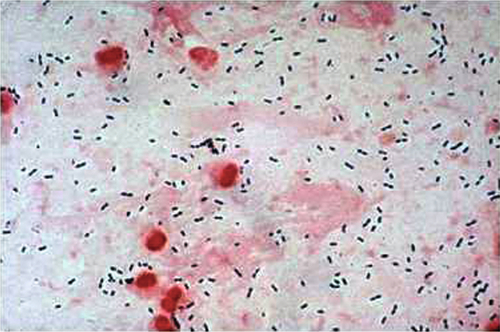


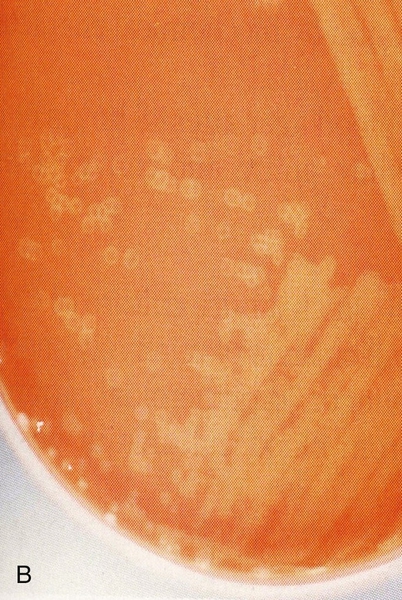
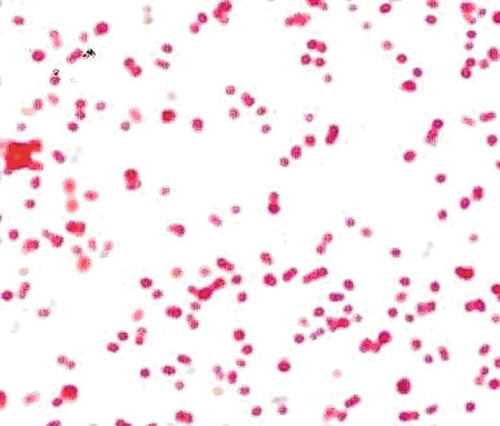
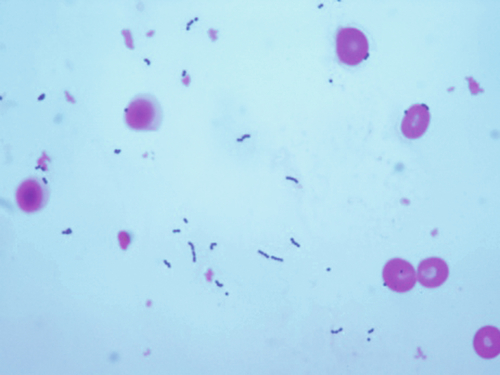
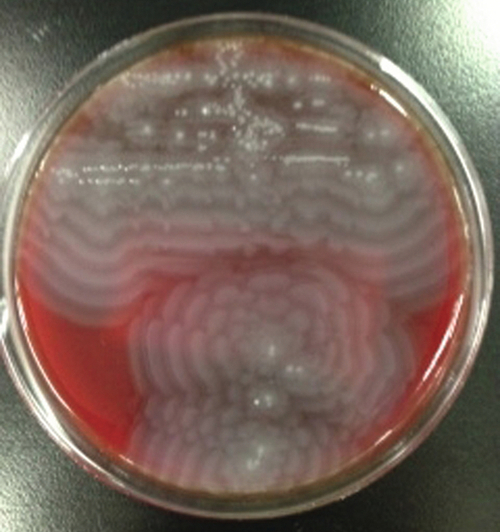
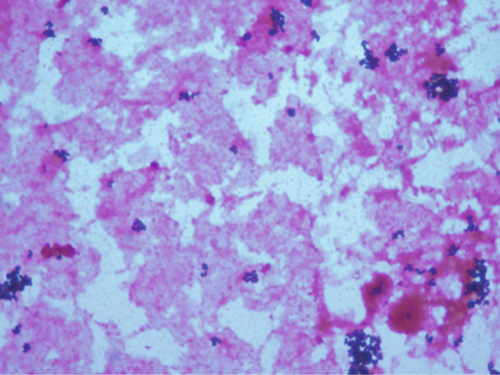
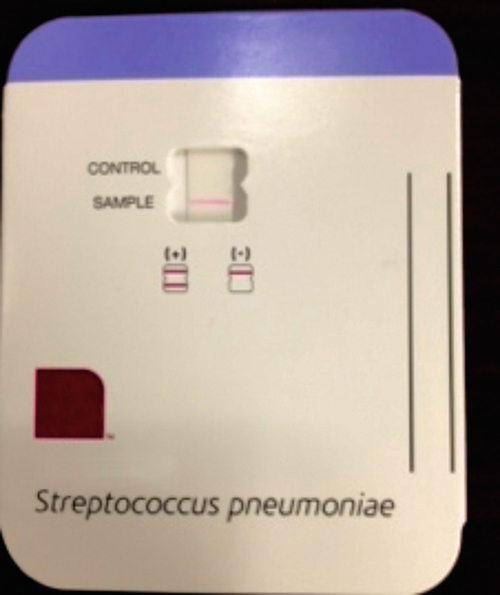



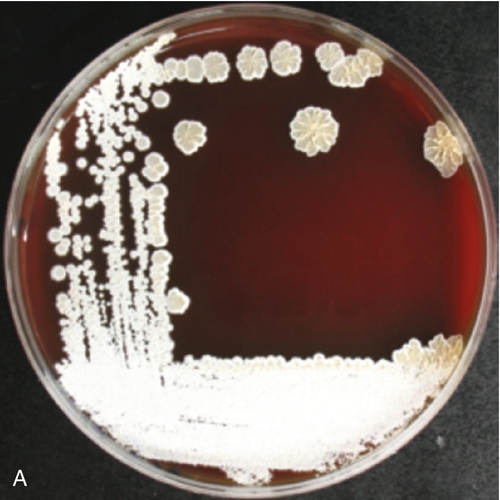


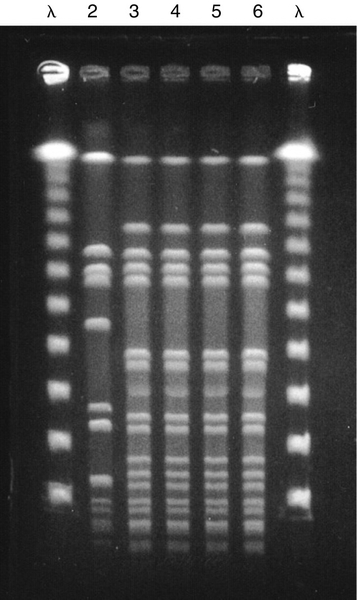
Mycobacteriology
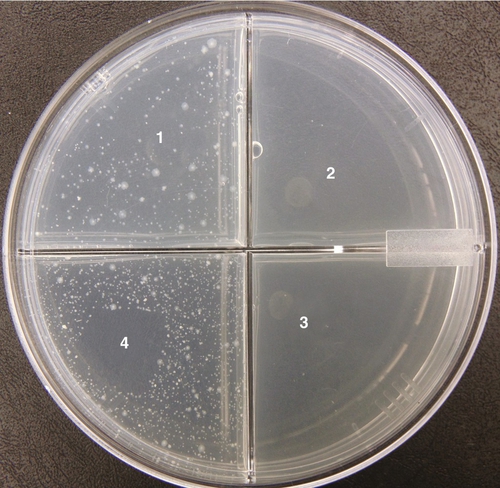
Mycology

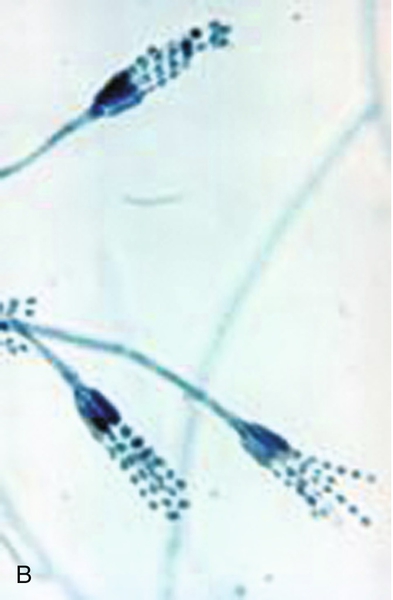
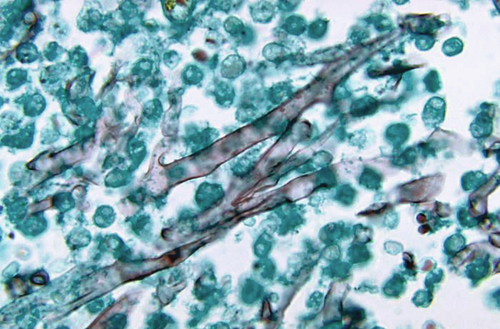
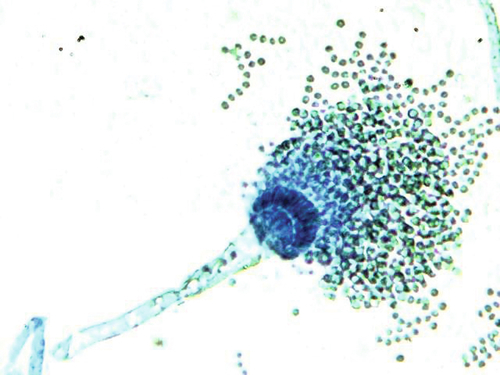

Stay updated, free articles. Join our Telegram channel

Full access? Get Clinical Tree


Microbiology: Bacteriology, Mycobacteriology, Mycology
Figure 16-1 Photomicrograph showing gram-positive organisms along with neutrophils.
Figure 16-2 Photomicrographs showing gram-positive organisms.
Figure 16-3 A, Photomicrograph of the Gram stain of the organism isolated from the blood of this patient. B, Colonial morphology and the type of hemolysis elicited by its growth.
Figure 16-4 Photomicrograph illustrating Gram stain and the cellular morphology of a pathogen present in cerebrospinal fluid.
Figure 16-5 Photomicrographshowing gram-positive organisms. Several red blood cells from the blood culture bottle are also seen (× 1000).
Figure 16-6 Colonial morphology of the pathogen. The results of this urine culture demonstrate waves of bacterial growth on a 5% sheep blood agar plate.
Figure 16-7 Photomicrograph showing gram-positive organisms isolated from the patient’s blood.
Figure 16-8 Bacterial identification using a rapid test device. The results of a urine specimen from a patient with community-acquired pneumonia are shown.
Figure 16-9 Photomicrograph showing the gram-stained organism isolated from the stool of a patient with diarrhea.
Figure 16-10 To perform the Hodge test for identifying KPC-carbapenemase producing organisms, an agar plate is streaked with a carbapenem-susceptible Escherichia coli, an ertapenem disk is placed in the center, and the test organisms are streaked out from the disk. This figure shows inactivation of ertapenem by a KPC-producing Klebsiella pneumoniae (+), distorting the zone of inhibition of E. coli. KPC-negative organisms are also demonstrated (–), which show no distortion of the zone of inhibition of E. coli.
Figure 16-11 Colonial growth and oxidase test result of an organism cultured on a 5% sheep blood agar/MacConkey biplate.
Figure 16-12 A, Colonial growth and cellular morphology of an organism cultured from sputum after 3 days on a blood agar plate. B, Cellular morphology using a modified acid-fast stain (× 900).
Figure 16-13 Photomicrograph showing cellular morphology by Gram stain (× 1000) of the organism cultured from a brain abscess.
Figure 16-14 Pulsed-field gel electrophoresis analysis of methicillin-resistant Staphylococcus aureus isolates. Genetic profiles of these isolates were obtained by digesting chromosomal DNA with the Smal restriction endonuclease. Lanes 1 and 7 are λ markers. Lane 2 is a control strain. Lanes 3 to 6 are isolates from individual patients.
Figure 16-15 Agar proportion susceptibility test results for the organism isolated from a patient with Mycobacterium tuberculosis. 1, Isoniazid disk (1 μg); 2, rifampin disk (5 μg); 3, isoniazid disk (5 μg); 4, drug-free control disk.
Figure 16-16 A, Reverse colony morphology on a Sabouraud agar plate after 3 days of culture at 30°C. B, Wet mount of the organism (× 100).
Figure 16-17 Methenemine silver stain of the fungal elements found in a needle aspirate of the maxillary sinus of a bone marrow transplant recipient.
Figure 16-18 Photomicrograph showing cellular morphology of the organism isolated from the liver biopsy of a patient after 3 days of culture.
